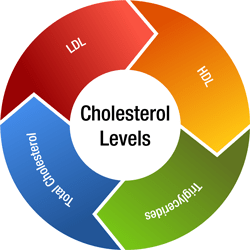Cholesterol: The Good, the Bad, and the Triglyceride
by Joe Wood
October 2021
According to the Minnesota State Health Department, heart disease is the second-leading cause of death for Minnesotans, following cancer as number one. Most heart disease is preventable, as is true specifically for myocardial infarctions, simply known as "heart attacks." Deaths from heart disease in Swift County is about 260 per 100,000, a statistic that suggests that every year 24 people in Swift County will die from a heart attack. One way healthcare providers can prevent these tragic events is by monitoring their patients' cholesterol and triglyceride levels.
Cholesterol is a waxy substance made by the liver and found in food, while "triglycerides" is just a fancy name for a form of fat the body uses for energy. Importantly, cholesterol and triglycerides aren't inherently bad. In fact, cholesterol has a variety of good things such as serving as an energy source. Yet, both cholesterol and triglycerides are bad when there's simply too much of these substances for the body to handle properly. At high levels, cholesterol, in particular, starts bulking up in all the wrong places until it causes harm and sometimes even lethal consequences.
 An important note is that there are
two types of cholesterol: HDL and LDL. The HDL is good
cholesterol (better at high levels) and LDL is bad
(better at low levels). Sometimes it's hard to remember
which cholesterol is good and which is bad. One
suggestion for keeping them straight: LDL starts with L –
better at Low levels – and HDL starts with H, better at
High levels. Another suggestion are these "H"and "L"
designations: "H" for Heroic and "L" for viLLainous
further remembered as the Heroic HDL is needed to fight
the viLLainous LDL.
An important note is that there are
two types of cholesterol: HDL and LDL. The HDL is good
cholesterol (better at high levels) and LDL is bad
(better at low levels). Sometimes it's hard to remember
which cholesterol is good and which is bad. One
suggestion for keeping them straight: LDL starts with L –
better at Low levels – and HDL starts with H, better at
High levels. Another suggestion are these "H"and "L"
designations: "H" for Heroic and "L" for viLLainous
further remembered as the Heroic HDL is needed to fight
the viLLainous LDL.
Always on the minds of parents and other adults is when cholesterol should be checked. Science has shown that family and personal history of high cholesterol are the strongest reasons for cholesterol evaluation. For example, having diabetes or excess body weight, being male, and having a family history of heart disease are risks factors that guide patient-provider discussions around when to check cholesterol levels. Cholesterol problems can start early and studies have shown that one of every five adolescents have high cholesterol. Children should be screened once between 9 to 11 years of age and if normal, again around age 17 to 21. Many times, this is done before graduating high school. For young individuals with low risk of heart disease, the Centers for Disease Control and Prevention recommend that cholesterol be first tested at age 20 followed by repeat testing every five years.
Cholesterol screening involves a blood test commonly called a lipid panel. The panel looks at four numbers, three are important for cholesterol and the fourth is the triglyceride level. Because cholesterol results can be pretty confusing, for people without heart disease, keep three standard numbers in mind: 200, 100, 60. Total cholesterol should be near or below 200 mg/dl; and the "viLLainously bad" or LDL cholesterol should be about or lower than 100 mg/dl. Healthcare providers prefer to see the Heroic HDL about 60 mg/dl. Triglycerides should register below 150 mg/dl.
For patients who've already had heart attacks, healthcare providers will suggest different standards for these numbers. To prevent disease in people who've not yet had cholesterol-related problems, healthcare providers will offer a variety of treatment options tailored to the specific abnormal number, a patient's health issues, and treatment preference.
 Patients should be
aware that time and time again diet and exercise changes
have shown to be more effective than any medications
currently available. A good start to improving a diet can
be found from the Department of Agriculture guidelines
found on their website. "My Plate" which shows a
dinner plate divided into four sections: Grains and
vegetables occupy two sections that are about 60% of the
total and a bit larger than the other two sections for
fruits and protein, also of equal size making up the
other 40%.
Patients should be
aware that time and time again diet and exercise changes
have shown to be more effective than any medications
currently available. A good start to improving a diet can
be found from the Department of Agriculture guidelines
found on their website. "My Plate" which shows a
dinner plate divided into four sections: Grains and
vegetables occupy two sections that are about 60% of the
total and a bit larger than the other two sections for
fruits and protein, also of equal size making up the
other 40%.
For exercise, there are plenty of programs available. For anyone just starting an exercise program, the National Institutes of Health recommends focusing on advancing activity slowly, even with just increasing the time associated with a standing activity. Another recommendation is light activity which is more recreational and could involve things like carpentry, golf, or walking a mile in less than 25 minutes. As those activities become easier, next comes moving to a moderate intensity activity such as gardening, bicycling, tennis, or a 15-minute mile walk. The final category is high intensity activity: soccer, walking uphill with weight, or a 10-minute mile walk. Regardless of intensity, a universal goal should aim for 200 minutes of activity per week. Because any increase of any activity will help, combining exercise with the correct diet will reduce weight and improve cholesterol.
However, sometimes in addition to diet and exercise, medication is still necessary. The usual medication started is in a category providers commonly refer to as "statins." Statins work by lowering the liver's ability to make cholesterol and by pulling cholesterol out of the bloodstream. Some statins are more effective at doing this than others and results often show they can lower bad cholesterol by almost 50%.
No discussion about medications is complete without a discussion about medication side effects. Statins have been used for decades and are safe when taken and monitored correctly. Anyone taking a statin who finds themselves having muscle pain should immediately report that symptom to their provider. Though it's unclear why this symptom occurs, the medication can be adjusted, or stopped with another substitution prescribed. Statins also can irritate the liver and providers will also regularly monitor for this problem which is usually without symptoms.
Knowing basic information about cholesterol and triglycerides is important. Medical providers – including those in Swift County and the surrounding areas – want to help local residents know and control their cholesterol levels. With this knowledge, Swift County residents should not hesitate to have a conversation about cholesterol screening and treatment.
This article also appeared in the October 20, 2021 issue of the Swift County Monitor.
About the Author
 Joe Wood is a third-year medical student at the
University of North Dakota School of Medicine & Health
Sciences. He was selected as the Benson participant for
the school's ROME program, or Rural Opportunities in
Medical Education. The program includes teaching student
doctors the importance of rural newspapers. As a future
rural healthcare leader, Wood has written this column to
provide health information for his ROME community. The
information is not for diagnosis or treatment and should
not be used in place of previous medical advice provided
by a licensed practitioner.
Joe Wood is a third-year medical student at the
University of North Dakota School of Medicine & Health
Sciences. He was selected as the Benson participant for
the school's ROME program, or Rural Opportunities in
Medical Education. The program includes teaching student
doctors the importance of rural newspapers. As a future
rural healthcare leader, Wood has written this column to
provide health information for his ROME community. The
information is not for diagnosis or treatment and should
not be used in place of previous medical advice provided
by a licensed practitioner.
